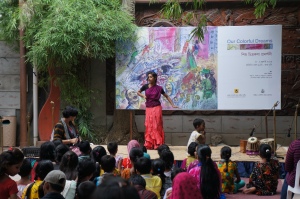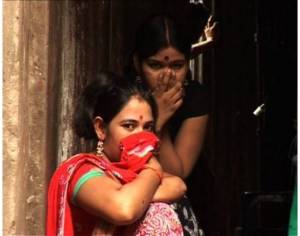Dhaka is so much more than just a city. It is a whirlpool that pulls anything and anyone that comes close to it – sending them around and around like some wildly spinning fairground ride bursting with energy. It is organized chaos – millions of individual pursuits churning together into frenetic collective activity. I cannot guarantee you’ll fall for Dhaka’s many charms, but sooner or later you will start to move to its beat. And when that happens, Dhaka stops being a terrifying ride and starts to become a unique blend of art and intellect, passion and poverty, love and hate.
The charms of Dhaka are not immediately visible to the naked eye – they are dhaka (hidden in Bengali). Not that there are hordes of visitors trying to uncover those charms; this is a city that remains largely untouched by tourists. The city is what it is, a place in perpetual motion, the glorious chaos of which is perhaps best viewed from the back of one of the city’s half-a-million colorful rickshaws. As someone who has called this place his home for some 20 years, here is my list of the essential things-to-do/sights-to-see while in Dhaka.
1. Take a rickshaw through the busy streets
There are cycle-rickshaws all over Asia, but in Bangladesh they are more colorful, more prevalent and more integral to everyday life than anywhere else. Rickshaws are an art form in their own right. They are plentiful around Dhaka, and the best way to explore the city like a local. They are cheap, fun, environmentally friendly and are often the quickest way to get through the busy streets. And speaking of busy streets, might I add that Dhaka has some of the worst traffic in the world. You may find yourself amongst a standstill – rickshaw drives screaming, buses honking, traffic lights functioning as mere decorations. But this is just part of the city. So sit back and enjoy this organized chaos!
2. Explore Old Dhaka
For some, the assault on the senses is too much to handle, but for others, the unrivaled mayhem that is squeezed into the narrow streets of Old Dhaka is simply delightful. No matter where you’ve come from, or what big cities you’ve visited before, Old Dhaka will knock you for six (a cricket reference) with its manic streets and nonstop noise and commotion. Nestled in the cacophony are structures from a bygone era – Ahsan Manjil, home of the Nawabs, and the Lalbag Kella, a Mughal fort. Some of the most amazing food in the city is to be had in hole-in-the-wall stores such as Haji Biryani and Nana Biryani.
3. A boat ride on Buriganga
Running calmly through the center of Old Dhaka, the Buriganga River (Old Lady Ganga) is the muddy artery of Dhaka and the very lifeblood of the city, and perhaps the nation. To explore it from the deck of a small boat is to see Bangladesh at its most raw and gritty. The panorama of river life is fascinating. Boats of all shape and size compete for space and motion, with children dotting the foreshores, fishing with homemade nets. On the banks of the river is Shadarghat, perhaps one of the busiest loading docks in existence. You can take a rocket (steamboat) to other cities in Bangladesh – Barisal, Comilla and Chandpur to name a few. As you cross from Dhaka to Old Dhaka to the Buriganga, life speeds up, and then hits the brakes to arrive at a watery sunset.
4. Drink a cha, eat some fuchka
Dhaka runs on cha (or chai). These sweet, milky, hot cups of tea are a Bangladeshi style caffeine fix. Add some street food, and you have got yourself the perfect desi snack. The local street food fare includes fuchka, chatpati, and jhalmuri to name just a few. Head to Dhanmondi Lake or just about any intersection in the city to get your daily dose of some of the best street food you’ll ever taste.
5. Sangsad Bhaban
The parliament building of Bangladesh is a true architectural masterpiece – the magnum opus of the American architect, Louis Kahn. It blends motifs from ruined monuments and Bangladesh’s topography, with a remarkable use of natural light. The Sangsad Bhaban lies on a vast area in the middle of the city, seemingly floating on a lake, a refuge within the bustling city.
6. Festivals
Festivals have always played a significant role in the life of the people of Bangladesh. They are parts and parcels of Bengali culture and tradition, and no matter when you visit Dhaka, there’s indefinitely one to find. Here’s a list of some of the bigger ones:
- Pahela Baishakh – The advent of Bengali New Year is celebrated throughout the country. The best place to celebrate is Ramna Park, where perhaps a million people will take part in an exhibition of Bengali culture. Make sure to grab a plate of panta rice with Elish fish while you are there. Pahela Baishakh follows the Bengali calendar and takes place mid-April.
- Shadhinota Dibosh – The independence day of Bangladesh is March 26. Independent for four decades, the war is still a huge part of society here and the independence day is a show of nationalistic pride. Citizens including government leaders and sociopolitical organizations and freedom fighters place floral wreaths at the National Martyrs Monument at Savar. At night the city is illuminated with lights.
- Ekushey February – The 21st of February is observed throughout the country to pay homage to the martyrs’ of Language Movement of 1952. It is now regarded as the World Mother Language Day. This is quite a unique occasion – somewhere in between a festival and a mourning day. The Shahid Minar (martyrs monument) is the symbol of sacrifice for Bangla, the mother tongue.
- Nabanno, Eid, Durga Puja, and others – There’s almost too many to list here, but Nabanno (festival of the new harvest), Eid and Durga Puja just have to mentioned. No matter what your religion, Eid and Puja are cause of celebration in Dhaka.
7. Explore the history
Bangladesh is probably one of the few nations whose citizens have experienced two independence struggles – from from British colonial rule and then liberation from Pakistan in 1971. Although the war was over four decades ago, its presence is everywhere. It’s hard to open a paper, speak to a writer, or discuss politics without hearing the words “71,” “martyr” or “freedom fighter.” The Liberation War Museum is a fascinating if at times gruesome look at that struggle, with lots of press clippings and other memorabilia from that time. If you’re new to Bangladesh, this is an important starting point for understanding the national obsession.
8. The mosque and the temple
Dhaka is dotted with numerous mosques and temples. These are more than just religious institutions, since religion and culture are so intertwined in peoples lives in Bangladesh. Head to the 1,200 year old Dhakeshwari Temple, the center of the Hindu religion in Dhaka and then to the Tara Masjid, the beautiful 18th century mosque adorned with mosaic stars. You don’t have to belong to any particular faith to appreciate the beauty of these structures, and in doing so, you’ll get a glimpse of an integral part of culture and society here.
9. Art, music and literature
Bangladesh is rich in art, music and literature, and there are few better places to get a taste of the arts than Dhaka. Head to the Bengal Gallery of Fine Arts or the Drik Gallery to sample some of the contemporary art, which frequently makes a social commentary. The music scene in Dhaka is HUGE! From the classical works of Rabindranath Tagore and Nazrul Islam, to pop and heavy metal – there’s a concert to go to for everyone. Follow ConcertNews to find the next one.
Bengalis love to read, and there’s no better place to experience this passion for books than Nilkhet. Sandwiched between Dhaka University and New Market, this labyrinth of bookstores will satisfy and enlighten even the best-read visitor. Dhaka also hosts one of the biggest book fairs in the world, the Ekushey Book Fair.
And if you’re in the mood for shopping, you are in luck. Dhaka is one of the shopping hubs of South Asia. Head to New Market, Doyel Chattor, Bashundhara or Chandni Chawk and you will find pretty much anything.
10. Add yours here!
I started to write this thinking I’ll list 10 things. But to pick 10 things to do in this megalopolis that is home to me, is almost impossible. I’ll keep adding recommendations as comments, and I ask my readers to do so too. I don’t expect, or want Dhaka to turn into a tourist destination. But I want it to be appreciated for what it is – a city in perpetual motion, an experience that will side-swipe you with its overwhelming intensity, leaving impressions that will never fade.














